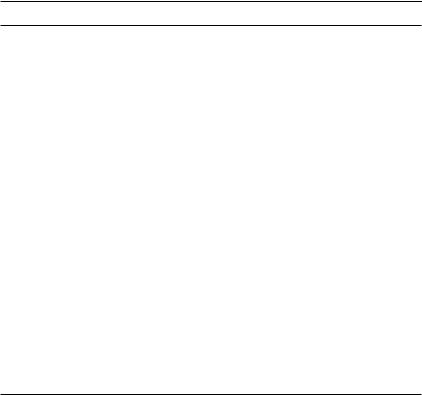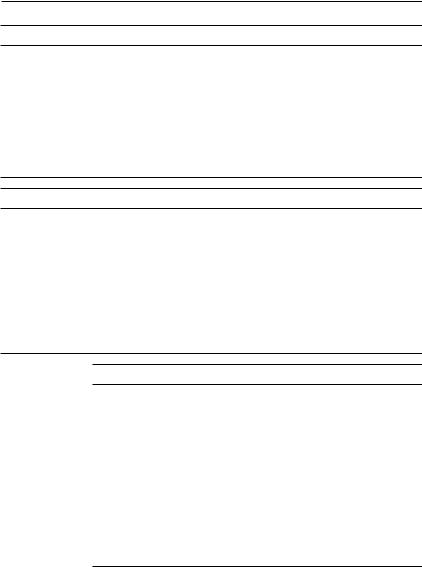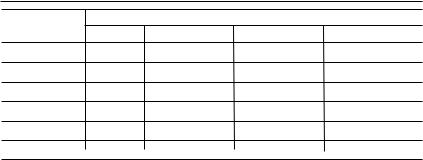
0229836_9011C_jack_koumi_designing_educational_video_and_multimedia_for_op-1
.pdf
64 Media selection and deployment
sum of attributes of its constituent media. In addition, the computer package has the potential for much more refined interactive design.
The analysis of the above media will consider seven types of media characteristics:
•symbol system (or presentational attributes) – the types of symbols the medium uses to communicate, e.g. text and/or moving pictures and/or sound.
•access – the extent to which students are in a position to use the medium for learning
•controllability – how much influence can be exerted by students over the way they make use of the medium
•student reactivity – opportunities provided by the medium for student activity (including mental activity)
•interactivity – an action by a student receives feedback from the medium (according with the definition by Laurillard 1993: 100)
•adaptivity – the medium is able to adapt its provision to suit an individual’s needs, emulating the ability of an expert human teacher (according with the definition by Laurillard 1993: 100)
•networking – the medium enables cooperation among learners and between learners and teachers
Comparative merits of media
The concept of comparative merits between media is offered as a more fruitful idea than the usual advantages and disadvantages of individual media. For example, print is rather impersonal whereas audio-visual media can portray the teacher in person. This pair of evaluations can be expressed as a single comparison, namely:
Personalizing the teacher is a merit of audio-visual media compared to print.
In the last ten years, participants of workshops held in several countries have helped to build up a substantial list of such comparative merits. Table 4.1 gathers together those merits that such contributors have agreed are important for rational deployment of different media to different learning contexts and tasks.
To get familiar with Table 4.1, consider just one item from each of the first four sections. Each item in the table is a desirable feature, something that we want, like personalizing the teacher. This appears in section 1 (item 1.4) because personalization of teachers is better achieved by audio-visual media than by print. Notice that the merits in section 1 apply to all audio-visual media, whether broadcast (TV and radio) or distributed as videoand audio-recorded on cassette

Matching media attributes to learning tasks and teaching functions 65
Table 4.1 Comparative merits and distinctive teaching attributes of six different media: print, TV and radio (broadcast), video and audio (recordings), audiovision (audio + notes/visuals)
1 Audio-visual (broadcast or recorded) over Print
1.1unique ways to help learning, e.g. drama, animation, demonstration
1.2provision of realistic experiences, e.g. sounds, places, events
1.3the medium’s realism has a strong impact on attitudes, appreciations, motivations
1.4personalization of teachers
1.5breaks the tedium of print
(See Table 4.2 for a finer subdivision of 1.1 to 1.5)
1.6literacy is not essential
2 Print over Audio-visual (broadcast or recorded)
2.1random access at the student’s own pace helps the study of
•data in quantity, e.g. glossary, study guide
•fine detail, e.g. equations, photos
2.2student can browse and select more easily
2.3print can carry more information
2.4print is adequate to cover most of syllabus
2.5easier teacher access/control
2.6production skills are adequately resourced (See Table 4.3 for more detail on 2.1 to 2.6)
2.7reception is not affected by power outages
2.8family does not dispute access
3 Broadcast A/V over Print or A/V recording
3.1cheaper for large audiences
3.2study pacing (obliged by broadcast schedule)
3.3sense of importance
3.4sense of community
3.5sense of immediacy
3.6non-stop is good for presenting an overview
3.7recruitment of students
3.8public/academic exposure
3.9national resource
3.10top experts agree to appear
4 Print or A/V recording over Broadcast A/V
4.1student can study when prepared and alert
4.2student can stop and reflect, annotate notes, hence the medium can carry greater detail
4.3student chooses repeats
4.4lessons can have variable length
4.5lesson can be subdivided into digestible segments, with interspersed activities
4.6A/V recording is better for group discussion
4.7frequency of lessons can be varied
4.8can carry socially sensitive material
4.9entertainment industry hogs broadcasts
(continued …)

66 Media selection and deployment
Table 4.1 Continued
5 TV/video over Radio/audio recording
5.1more compelling, in general
5.2more interesting/glamorous to produce
5.3engages more than one sense (vision and hearing)
6 Radio/audio recording over TV/video
6.1student access to (cheaper) equipment
6.2cheaper to produce and deliver
6.3evoked images are better!
6.4translation is easier to implement
6.5portability of equipment
6.6can listen while driving
7 Video over Audio recording with notes/visuals
7.1the field of view is predetermined
7.2when moving pictures are needed
7.3pictures and sound can be synchronized
7.4video has picture-search facility
8 Audio recording with notes/visuals over Video
8.1student choice of when to look where
8.2cost effective when topic needs pictures but not moving pictures
8.3adequate production skills easier to achieve
9 Audio recording with notes/visuals over Print
9.1verbal commentary for diagrams is easier to learn from than margin notes for diagrams
9.2students can revise more easily from the sparse notes (without replaying the audio)
9.3(with or without notes) spoken words help pronunciation; pacing/intonation add meaning
or disk. So in section 1 we are comparing a group of four audio-visual media with a single medium, print.
In contrast, section 3 contains merits of broadcast audio-visual over print or cassette/disk. One example, 3.7, is the greater potential of broadcast audiovisual for recruiting students. That is, recruitment of students is better achieved by broadcast audio-visual media (TV or radio) than by recorded video/audio or print. This is because of the wider exposure that can be achieved by broadcasts. So, in section 3, we are comparing TV and radio with recorded video and audio and print.
Conversely, example 4.4 in section 4 is a desirable feature of both print and audio-visual recording which cannot be accommodated easily by broadcast: namely, variable length. (Broadcast schedules normally require standard duration of broadcast slots.)
Incidentally, concerning audio-visual recordings, I’m assuming these are not merely recorded copies of broadcast-style programmes but that their design has exploited the controllability of the cassette player or disk player. For example, a video recording might contain several self-contained segments, separated by captions that advise students to stop the video and carry out activities related to

Matching media attributes to learning tasks and teaching functions 67
the previous segment. In addition, the recording (whether audio or video) might be accompanied by complementary notes for reference and for guiding interspersed activities. Even without complementary notes, the controllability of recordings confers them with many advantages over broadcasts – all the advantages listed in section 4.
Finally, section 2 contains an example, numbered 2.7, which illustrates the converse of the items in section 1, namely an advantage of print over audio-visual media: the study of print is not prevented (in daylight) by electrical power outages (interruptions of electrical power supply). This advantage of print would of course cease to apply if electrical power outages never occurred, as is almost the case in developed countries.
Such technological differences, as well as institutional and cultural differences, may exist for other comparative merits. For example, it is conceivable that the broadcasting time allocated to your institution is plentiful, so that you are not worried about wasting transmission time. In which case, variable length (item 4.4) may be feasible for your broadcasts (not just for your print and audio-visual recordings). Additionally, there may be good educational reasons for broadcasting fillers – short programmes to plug the gaps left by variable-length broadcast programmes (although this could be expensive due to the loss of economy of scale).
The first six sections involve the following five media, in various groupings
•four audio-visual media: radio and TV (broadcast), audio and video (recording)
Concerning audio-visual recordings, as mentioned earlier, it is assumed that these are not merely recorded copies of broadcast-style programmes but that their design has exploited the controllability of the cassette or disk player. In other words, students can stop when they are so advised, or whenever they wish, and carry out some activities. The first six sections apply both to the case when audio-visual recordings stand alone and when there are complementary notes for reference and for guiding interspersed activities.
In categories 7, 8 and 9, Table 4.1 makes special mention of such notes for audio-recordings. This is because, unlike video, the notes can convert audio into a very different medium. This is accomplished by presenting the key ideas of the package in the notes, while the audio commentary guides students through these ideas. This composite medium is our sixth audio-visual medium, sometimes referred to as audiovision. It has met with considerable success in the UK Open University (Bates 1984: 205). For a description of some examples of the OU’s use of audiovision, see Koumi (1994b).
Notice that the sections come in opposite pairs down to section 8. Section 1 is the opposite comparison to section 2, section 3 is the opposite comparison to section 4, and so on. Looking at sections 3 and 4, for example, in section 3 we

68 Media selection and deployment
see that for some purposes broadcast is better than non-broadcast, but for other purposes, in section 4, non-broadcast is better than broadcast.
Computer packages will be tackled in more detail later, but there are some preliminary points related to Table 4.1, as follows. Items 1.1 to 1.5 of Table 4.1 are reasons for including video whether it stands alone or as part of a computer package. (Table 4.2 goes into this in more detail.) Sections 7 and 8 compare video with audiovision. However, there is a connection with computer packages. Consider a section of a computer package that contains no video but has an audiotrack and also graphics that change at specific points of the audio-track (audiosynchronized graphics). The effect is similar to audiovision (where an unlinked audio-recording guides students through a series of graphics). Not all the items in sections 7 and 8 apply to computer packages, mainly because in audiovision the visual changes are under the control of the student. However item 7.2 does apply as a reason for preferring video over audio-synchronized graphics. That is, if a particular topic in the package benefits from using moving pictures, then a video sequence is preferable to a sequence of audio-synchronized graphics. Item 8.2 also applies in reverse, as a reason for preferring audio-synchronized graphics over video (when pictures are needed but not moving pictures).
For each of the individual merits in Table 4.1, the reason why some media excel over others comes down to one or more of the seven media characteristics mentioned earlier
•symbol system
•access
•controllability
•student reactivity
•interactivity
•adaptivity
•networking
Here are some examples. Most of the merits in category 3 of Table 4.1 derive from the wider access afforded by broadcasts (e.g. 3.7, recruitment of students, and 3.9, national resource). Now consider category 2, advantages 2.1, studying fine detail and quantities of data, and 2.2, browsing and selecting. Students’ greater control over the study of print empowers print with both advantages.
The same is true of most items in category 4 of Table 4.1, advantages of print or audio-visual recording over broadcasting. Most derive their advantage from the greater control that students (and/or teachers) have over the way they make use of the medium.
For some items, the advantage derives from more than one media characteristic. This is true of item 4.5, lesson can be subdivided into digestible segments, with interspersed activities. Subdividing into chunks is a consequence of teacher control over the length of chunks. Interspersed activities enable student reactivity.

Matching media attributes to learning tasks and teaching functions 69
Thus far, only six media have been compared. Still to be addressed are the varieties of computer-based media, which are potentially more interactive and adaptive and which can enable networking, although problems of access can arise. These comparisons will be discussed after a more detailed analysis of the symbol systems of audio-visual media: these systems empower them with distinctive techniques and teaching functions, which print and human teachers cannot match. Questions of access and controllability will also come in.
Distinctive attributes, techniques and teaching functions for each medium
The purpose of this section is to develop an inventory of the distinctive pedagogic attributes of our six audio-visual media (excluding computers). For each medium we try to determine the techniques and teaching functions that are better served by that medium than by the others. This section goes into finer detail than Table 4.1, which groups together several media and compares this group with another group of media – a many-to-many comparison. In contrast, this section embarks on a one over all others comparison – it takes each medium in turn and identifies those teaching functions for which it excels over all other media.
The inventory of attributes is intended to supply pedagogic criteria for optimal media selection. From this, course developers can match each topic and learning task with the medium whose characteristics would best benefit that topic/task.
Practices at the UK Open University will be used as a sounding board for the recommendations made in this chapter. Before 1995, the use of multimedia computer packages and the internet were not widespread in the courses of the UK Open University. Hence the practices used before that date are quoted below regarding the first six media.
In order to exploit each medium’s presentational attributes fully, the UK OU tries to select that medium which best benefits the nature of each topic or learning task, subject to budgetary and resource constraints. Up until the early 1990s, this aim resulted in a media mix in which UK OU students spent:
•5 per cent of their study-time working with video (including work on broadcast notes)
•15 per cent working with audio or audiovision
•80 per cent working with printed materials
These are average figures: there were some individual courses where video work constituted as much as 50 per cent of study-time.
Since 1995, the OU’s use of multimedia computer packages and the internet has increased rapidly. More and more courses distribute CD-ROMs. By 1999, half of the courses offered computer conferencing and several courses presented their content totally online (via the internet).

70 Media selection and deployment
However the traditional single media have not been abandoned. Over half of OU courses still distributed audio-recordings in the year 2000. (Although only one course still transmitted radio programmes that year.) As for video recordings, if anything, the proportion of student study-time has increased since 1995. However, trying to present precise figures poses difficulties, for the following reasons.
Many of the CD-ROMs include video and audio, but the time spent by students on these constituent media has not been estimated in general. Hence it is no longer possible to provide an overall estimate of student time spent on all the video offerings. Similarly for audio. Another difficulty with such estimates is that courses have become so diverse that it would be very misleading to quote an average breakdown of student time spent on different media.
Returning to our first six media (excluding computer packages and computer mediation), the inventory below is an approximation of UK OU practice, although the OU does not work to an explicit formula like this.
Television and video
Table 0.1, in Part I of this book, expands on the techniques and teaching functions that were thought by the UK OU to exploit the distinctive presentational attributes of TV. For convenience, Table 0.1 is reproduced here as Table 4.2.
This array of techniques and teaching functions enable a wide range of learning outcomes. These outcomes will be discussed in terms of the two-dimensional matrix of cognitive outcomes in Figure 4.1. This proposes a taxonomy of six cognitive processes, each of which can be applied to four knowledge dimensions. For example, a learning outcome can be classified as (say) type 4/C: Analyse some procedural knowledge. A specific example of this type, in the subject of metalwork, could be: ‘Differentiate between welding and soldering’. Hence the taxonomy involves a total of 4 × 6 = 24 main types of learning outcome.
The full model has several subheadings under each of the cognitive processes and each of the knowledge dimensions. Further elaboration can be found in Appendix A2.1.
Categories of cognitive learning outcomes in bold font in Figure 4.1 can be achieved with non-stop viewing of self-standing video (no supplementary print). Namely, viewers can be enabled to remember and understand all four knowledge dimensions: facts, concepts, procedures and metacognitions (e.g. learning strategies, self-knowledge).
The categories in the table that are not in bold font indicate the kind of learning that cannot easily be achieved through non-stop viewing of video. That is, nonstop video is not an appropriate means of achieving the four highest level cognitive processes, apply, analyse, evaluate, create (although all of these are possible to some extent, especially applying). Moreover, even for the learning outcomes that are easily achieved, non-stop video is more suitable for providing overviews of the four knowledge dimensions rather than fine detail.

Matching media attributes to learning tasks and teaching functions 71
Table 4.2 Added value video techniques and teaching functions
1Distinctive ways to assist LEARNING and (item 9) SKILLS development
1composite pictures, e.g. split screen, S/I
2animated diagrams exploring processes 3 visual metaphor/symbolism/analogy
4 modelling a process by a simplification
5 illustrating concepts with real examples
6 condensing time by editing real life
7 juxtaposition of contrasting situations
8 narrative strength of TV’s rich symbol system
9 demonstration of skills by an expert
(e.g. craft, physical, reasoning, social, verbal)
2Providing (vicarious) EXPERIENCES by showing otherwise inaccessible:
1 dynamic pictorial change or movement
2 places, e.g. dangerous/overseas locations
3 viewpoints, e.g. aerial, big close-up
4 technical processes or equipment
5 3D objects, using movement or juxtaposition
6 slow/fast motion
7 people/animals interacting, real or drama 8 one-off or rare events (include archive film) 9 chronological sequence and duration
10resource-material for viewers to analyze
11staged events, e.g. complex experiments, dramatized enactments
3 NURTURING (motivations, feelings)
|
1 |
|
determination, |
|
|
|
|
|
motivation, |
2 |
|
activation |
|
|
|
|
|
|
|
3 |
|
|
|
|
|
|
|
4 |
|
|
|
|
appreciations, |
|
|
feelings, |
5 |
|
attitudes |
|
6 |
|
|
7 |
|
|
|
|
|
|
stimulate appetite to learn, e.g. by revealing the fascination of the subject
galvanize/spur into action, provoke viewers to get up and do things
motivate use of a strategy by showing its success, e.g. exam techniques
alleviate isolation of the distant learner by showing the teacher or fellow students
change attitudes, appreciations, engender empathy for people reassure, encourage self-confidence
authenticate academic abstractions by showing their use in solving real-life problems
Note however that remembering and understanding an overview of a knowledge topic is a useful (and sometimes even an essential) precursor of higher level processing of details. The reverse can also be true – an overview can provide a useful consolidation after a learner has undertaken concentrated study of detailed material, but has been left with a fragile grasp of the big picture. Whether or not an overview is better studied before or after studying details depends on the learning task and the individual learner.

72 Media selection and deployment
Cognitive |
Knowledge dimensions |
|
|
processes |
A. Facts |
B. Concepts |
C. Procedures D. Metacognitions |
1.Remember
2.Understand
3.Apply
4.Analyze
5.Evaluate
6.Create
Figure 4.1 Anderson and Krathwohl (eds) (2001) revision of Bloom’s Taxonomy. The full model has several subheadings under each of the cognitive processes and each of the knowledge dimensions. Further elaboration can be found in Appendix A2.1.
A c a v e a t
For television and video, and indeed for all media, we assume that production resources and staff expertise are adequate to get the best out of each medium. However the judgement of adequacy varies between different institutions. For example, as has been mentioned, a UK OU TV producer’s yearly load was between 6 and 8 half hour programmes. Koumi and Hung (1995) point out that this compares with more than 12 at the Indira Gandhi National OU in India and the Sukhotai Thammathirat OU in Thailand, more than 80 at the Chinese Radio and TV University and about 100 at Taiwan’s Open University.
Assuming that we do have the resources to get the best out of each medium, there are many circumstances and learning tasks in which media other than TV excel, as follows.
Pr i n t
Despite the wide variety of teaching functions for which TV and video is used (above), the UK OU believes that print is adequate for most OU study. The views of most distance teaching institutions are similar. Learning tasks for which print is probably more suitable than other media are
•for the presentation of precise, factually accurate information (Bates and Poole 2003: 175)
•when students need to study information in quantity, e.g. glossary, study guide (which is a crucial function for print)
•concentrated study at an individual pace for analysing fine detail, e.g. equations, diagrams, complex concepts, closely reasoned argument – and further when students are required to evaluate or create such material

Matching media attributes to learning tasks and teaching functions 73
ÎIn contrast, as noted earlier, non-stop video is more suitable for providing overviews rather than fine detail and for enabling lower level cognitive processes such as remembering, understanding and, to some extent, applying.
•where the student benefits from random access in order to skim and select (e.g. when students revise for an exam they sometimes need to search their printed booklets for scattered information on a particular point)
•text and graphics can carry more information per megabyte than audio or video
•print is adequate to cover most of the syllabus
•substitute for audio-visual media whenever audio-visual production skills and equipment are inadequately resourced (even in cases where video might have superior pedagogic potential)
Occasionally, a learning task that appears at first sight to need video is better presented in print. For example, a series of stills (photographs) in text can substitute for a video animation. Sometimes this is more effective – when the changes at each stage are complicated and need individually paced contemplation, thus encouraging students to visualize the in-between images for themselves.
Returning to the cognitive taxonomy, Figure 4.1, what learning tasks can the print medium enable students to achieve?
An invitation to reflect on learning outcomes that the print medium can enable First, the four knowledge dimensions, A, B, C, D – can all four be achieved?
Think about this before reading on.
My view: it’s difficult to generalize, but my feeling is that print may not be as good as video for dimension B, abstract concepts (see Table 4.1, item 1.5) and C, procedures (skills) (see Table 4.1, item 1.9).
Now for cognitive processes: can print do better than video or worse? Again, think about this before reading on.
My view: ‘apply knowledge’ (3) is better achieved through print, due to reflection-time. The same holds for ‘analyse’ (4) and ‘evaluate’ (5).
What about ‘create’ (6)?
My view: the ability to create may be severely limited by the fact that we have a one-way medium. The potential of interactive, dialogic teaching and learning is examined later in this chapter.
Recorded video (usually with supplementary notes), designed to be viewed in short segments
The contrast was made above between the suitability of print for concentrated study and of non-stop video or TV for providing overviews and lower level processing of knowledge. There are also learning tasks that are intermediate between
